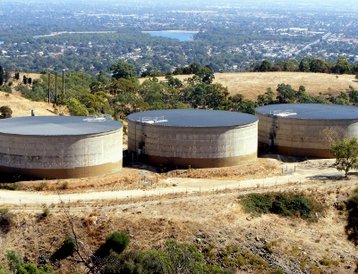If you manage a data center, you need smart water management strategy. Fortunately, practical solutions to make that happen are available today.
Smart water management is a growing necessity because of two colliding challenges: the need for more data centers around the world and increasing global water scarcity. As the volume of data traffic grows –think of video streaming, smart home applications and 5G networks – we’ll need significantly more processing power. In Southern California alone, there was a 23 percent increase in data center leasing in 2018. Some companies are doubling their capacity each year. The same trendlines exist worldwide: Mobile data traffic in the Middle East and Africa is growing at a rate of 65 percent per year.
At the same time, many data centers are cooled with water, which is not the plentiful commodity it once was. Two billion people are already living in water-stressed areas and the UN projects a 40 percent water shortfall by 2030 if the world keeps using water at the same rate it is today.
Combine these facts and it’s not hard to see that the data center industry must learn to do more with less water. For data center operators who fail to do this, the future may hold various kinds of trouble, including drought-induced service outages and conflicts with local communities vying for the same water.
Now is the time to make smart choices
Although data centers have been targeted for their water usage, such as during California’s recent years-long drought, operators are typically more concerned about energy. But a data center’s energy demands involve more than just powering the electronics. Data centers that use water more efficiently will consume less energy, which means they’ll reduce CO2 emissions, save money and decrease stress placed on local watersheds.
A recent survey from Ecolab [Ed: which owns Nalco] and GreenBiz showed that, while 88 percent of companies aim to take action on sustainable water management, 44 percent don’t have a plan to make it happen. For many companies, it’s a matter of not knowing what steps to take. But the roadmap toward smart water management is available. To identify the all-important first steps, ask yourself these questions:
Where are you sourcing your water?
Water is local. Is your area prone to droughts or flooding? Are there water quality or pollution issues? How reliable is your water supply?
Many data center operators are not aware enough of these risks. In most places, water is underpriced, meaning that the monthly water bill doesn’t reflect the financial risk due to water issues. This inhibits action because the perceived return on investment for smart water management is low.
Savvy data center managers can use publicly available online tools that determine the risk-adjusted, real value of water for each of their locations, to identify their risk exposure and start making smart decisions about investments in reducing, reusing and recycling water.
What is your water resiliency plan?
According to the Uptime Institute, data centers typically use eight million gallons of water per megawatt of electricity used. Facilities in regions with significant water risk should have plans to ensure service in case of supply interruptions. Do you have an alternative source of water? Are you storing enough water on-site to maintain operations for a minimum of 12 hours - and preferably more - if supply is compromised?
But beyond preparing for acute crisis management, there is much data centers can do. That includes budgeting for future water price increases and engaging with external stakeholders, such as neighboring communities, industrial facilities, farmers and municipal government.
The latter - joint water stewardship with external partners in the watershed - sets the framework for collaborating on pro-active solutions that mitigate water issues before they become crises. It also builds relationships that can stave off future conflicts and protects a data center’s reputation.
How this happens in the real world
A good example of smart water management is a Microsoft data center, located in the water-challenged Leon Creek watershed outside San Antonio, Texas. When the facility assessed its water footprint, it found out that its risk-adjusted value was 11 times higher than the price on its monthly water bill.
The data center invested in technology which enabled it to start using recycled water (graywater) for cooling instead of potable water from the municipal pipes. This allowed the facility to save almost 60 million gallons of water and $140,000 per year.
Another large data management company built a water management roadmap for its locations in several different regions. The company analyzed each of its water-cooled facilities and identified 14 at-risk locations. The company is now deploying the appropriate technologies and water stewardship practices to bolster each individual data center.
These are just a few examples of how smart water practices enable data centers to reduce risk and increase resilience. The benefits stretch far beyond individual facilities or even the sector as a whole, because data centers support the growing digital economy and outages can have significant effects on almost every industry.
As global water scarcity and climate concerns push everyone to rethink their water use, data centers should be on the frontlines. Not only will it position them for success in a water-scarce world, it will also generate positive impacts for the community and lay the groundwork for the digital economy’s future growth.





